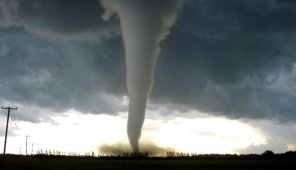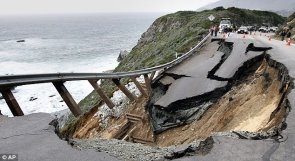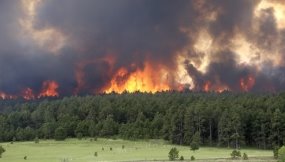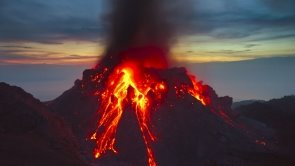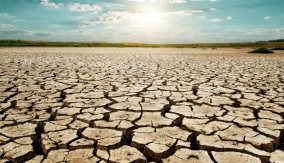Захист оточуючого середовища. Природні катастрофи.
Урок 1. Природні катастрофи.
Тип уроку: урок вивчення нового матеріалу
Мета уроку:
освітня: ознайомити учнів з новою лексикою, видами природних катастроф та явищ;
навчальна: практикувати у читанні та вимові нових слів, удосконалювати навички аудіювання, читання, говоріння;
розвиваюча: творче мислення, розвивати мовні здібності, здібності логічно висловлюватись; використовувати інформаційні технології для вивчення англійської мови;
виховна: формувати зацікавленість у вивченні англійської мови, працьовитість, виховувати уважність.
Учні повинні:
знати: лексику з теми «Природні катастрофи»;
вміти: сприймати опис природних катастроф на слух та описувати природні катастрофи самостійно.
Обладнання: комп’ютер з інтернет з’єднанням, телевізор, підручник “Solutions Pre-intermediate”, second Ukrainian edition, картки з завданням.
Хід уроку.
- Привітання. Розмова з учнями. (3 хвилини)
T: Good morning students. How are you today?
Ss: We are fine. Thank you. And how are you doing?
T: Oh, I am fine too. Thanks for asking. Well, I want to tell you that today we are beginning a new topic, which is very interesting to every person on this planet. But before we start, I want us to warm up a bit.
- Перевірка домашнього завдання. (2-5 хвилин)
Учні віддають вчителю міні-реферати за темою «Найдивакуватіші винаходи». (За бажанням учні презентують свої доповіді).
T: As far as I remember, at the previous lesson, we were finishing the topic about technology and inventions and your home task was to prepare short reports about the craziest inventions ever. I would like you to hand in your reports and if anyone wants to present his report, he is welcome to do it.
- Презентація теми уроку. (10 – 12 хвилин)
- Учням пропонується переглянути відео кліп «Пісня землі» М. Джексона (Ролик відкривається гарним пейзажем, кадри супроводжують акорди на фортепіано і скрипці. Джексон починає виконувати перший куплет, в якому він співає про те, як людство загубило природу. В цей час група південно-американських тубільців спостерігає, як відбувається вирубка гігантських тропічних дерев, а члени африканського племені бачать убитого слона з вирваними бивнями. Під час приспіву плавним переходом кадрів в ролику показано, як виглядали б ці сцени без людського втручання. Під час виконання другого куплету жителі європейського міста оглядають руїни своїх будинків після бомбардування. Джексон співає про світ без війни і засуджує неуцтво скоєних людьми помилок: «Де той світ, що ти обіцяв своєму єдиному синові?» («What about all the peace / That you pledge your only son?»). У композиції поступово наростає крещендо, в приспіві разом з Джексоном люди падають на коліна, з надією беруть в руки жмені землі і пропускають її крізь пальці. На всій планеті починається потужний ураган, під час якого безслідно зникає весь втрати, завдані Землі цивілізацією: вирубані ліси відновлюються, убиті браконьєрами тварини і загиблі в результаті військових дій люди оживають. На планеті запановує гармонія.).
Під час перегляду учні повинні запам’ятати якомога більше деталей, підсумувати, яке послання несе це відео, а також здогадатися, яку тему спілкування вони будуть розглядати. (2 хвилини)
T: Thank you it was a good game. I congratulate the winners. And now I want you to relax a bit and do what you really like to – watch a video. It is the video by a famous singer Michael Jackson. Have you ever heard his name? (S: Yes). But I cannot let you relax for even 5 minutes, so while watching the video, you will have some tasks to do. First of all, try to remember as much as you can of what you will see, then you will have to tell me about it. And try to think of the main message the song has in it. I am sure that if you do this, you will definitely guess what our new topic is.
- Учні переглядають відео https://www.youtube.com/watch?v=XAi3VTSdTxU та виконують завдання вчителя. (6 хвилин)
- Учні розповідають, що вони побачили та називають тему. (4 хвилини)
T: So, you have just seen a famous “Earth song” by Michael Jackson. What did you see? What do you think about the video?
S1: I have seen a lot of trees which first were green and then burnt.
S2: I have seen birds and dead animals.
S3: I have seen our planet destroyed by fire and sad people.
S4: I think it is a very touching video and song and the main message of it is for people to think about how they treat their home – Earth.
S5: I have also seen factories polluting air and I think that the topic we are going to discuss is “Environmental protection”.
T: Yes, my dear, you are quite right. During some lessons we are going to discuss the main environmental problems our planet faces and the ways to come over them. If you remember, at the beginning of the lesson I said we would discuss an issue important for every person on the planet. Was I right?
Ss: Yes.
- Введення лексичного матеріалу за темою «Природні катастрофи».
- Активізація усного мовлення. Вчитель пропонує учням поглянути на фото природних катастроф і відповісти чи бачили вони їх в реальному житті або в кіно. (2 хвилини)
T: Look at the photos and tell me if you have seen any of these events in real life. Have you seen them on TV?
Ss reply.
|
|
|
|
|
|
|
|
|
- Введення лексичного матеріалу.
Вчитель пропонує учням підібрати назви до явищ на картинках з поданого списку слів. (3 хвилини)
T: Now you have to match the photos with the six of the words below:
|
Natural disasters: avalanche, disease, drought, earthquake, famine, flood, forest fire, hurricane, landslide, tornado, tsunami, volcanic eruption. |
Відповіді: 1.tornado; 2.avalanche; 3.landslide; 4.forest fire; 5.volcanic eruption; 6.drought
- Первинне вживання нового лексичного матеріалу. (3+2 хвилини)
Учням пропонується в парах обговорити відповіді на запитання щодо природних явищ з попередньої вправи і розподілити їх на категорії згідно цих запитань.
T: Now you are going to have a short discussion with your neighbor. So look at the questions and answer them using the natural disasters from the previous exercise.
Which of the natural disasters involve:
- water (in any form) or no water?
- wind?
- very hot temperature?
- rocks or earth moving?
|
Відповіді:
|
Учні в парах роблять помітки, а потім обговорюють результати в групі.
- Застосування нового лексичного матеріалу. (6-8 хвилин)
Вчитель пропонує учням прослухати запис людей, які будуть описувати природні катастрофи та вирішити про яке з явищ говорить кожна людина.
(Перед прослуховуванням треба дати учням хвилину, щоб вони спробували уявити слова, які асоціюються з кожним природним явищем, наприклад лавина – гори, сніг і т.д.)
Після кожного речення треба зупиняти аудіо щоб учні встигли обрати природну катастрофу зі списку. Учні перевіряють відповіді у парах. Якщо треба повторити, не робіть паузи під час другого прослуховування.
T: Now that you are almost experts on natural disaster, I offer you to check how well you can understand people describing different natural phenomena. You will hear ten people talking. Your task is to decide which nature disaster each person is speaking about. While I am turning on the audio file, think of the words associated with each natural disaster.
Tapescript:
- We were skiing near to Chamonix in the Alps when the snow on the slope above us started to slide down towards us.
- It starts with a bad headache and sickness. People usually recover if they see a doctor quickly.
- The water is two metres deep in parts of the town. And the situation won’t get any better until the rain stops.
- We saw a huge wave moving towards the shore at a terrifying speed. Luckily we managed to escape to higher ground.
- I woke up suddenly in the middle of the night when my bed started to shake. It lasted about thirty seconds.
- The eruption started at 3 p.m. The mountainside exploded and millions of tonnes of lava flowed down into the sea.
- It hasn't rained for over six months in this part of Africa. The crops are dying in the fields.
- The flames swept through the dry forest, destroying thousands of hectares of trees.
- Heavy rains caused tonnes of rock and mud to slide down the mountainside, destroying a road and a railway line.
- If food doesn't reach the poorest region in the north of the country, then thousands of people will die of hunger.
Відповіді:
1 avalanche 2 disease 3 flood 4 tsunami 5 earthquake 6 volcanic eruption 7 drought 8 forest fire 9 landslide 10 famine
- Творче застосування отриманих знань. (5-7 хвилин)
Гра: Асоціації.
Вчитель пропонує одному з учнів вийти до дошки і стати до неї спиною, обличчям до класу. За його спиною на дисплеї з’являється фото з якоюсь з природних катастроф, що вивчалися на уроці. Учні, які бачать цю картинку, повинні по черзі називати слова, які в них асоціюються з цим явищем. А учень, який картинку не бачить повинен вгадати, що на ній зображено завдяки підказкам товаришів. Його місце займає той, після чиєї підказки слово було вгадане.
T: Well, you have done a great job today and now I want you to relax a bit and have fun. I need one volunteer who will come to the board. (S comes to the board. T shows the rest of the class a picture with a natural disaster.)
T: Now your task (to the rest of the class) is to help your friend guess what there is in the picture. You cannot say the name of the disaster itself, but one by one say a word that associates with it until our volunteer guesses what it is.
- Підбиття підсумків. Повідомлення домашнього завдання. (3-5 хвилин)
Вчитель повідомляє домашнє завдання та оцінки за урок.
T: Well, thank you very much for the game and for the lesson. Today you were excellent students and learnt a lot. So here is your hometask for the next lesson:
- Learn the natural disasters vocabulary (SB, p.74, ex.2);
- SB, p. 74, ex.6 – read the news report and complete the gaps with the suitable words from the list. Then write your own report using the one from ex.6 as an example.
ДОДАТОК. КАРТКИ З ЗАВДАННЯМ.
1.
|
TASK 1: match the photos with the six of the words below
Natural disasters: avalanche, disease, drought, earthquake, famine, flood, forest fire, hurricane, landslide, tornado, tsunami, volcanic eruption.
|
2.
|
TASK 2: look at the questions and answer them using the natural disasters from the previous exercise.
Which of the natural disasters involve:
|


про публікацію авторської розробки
Додати розробку

